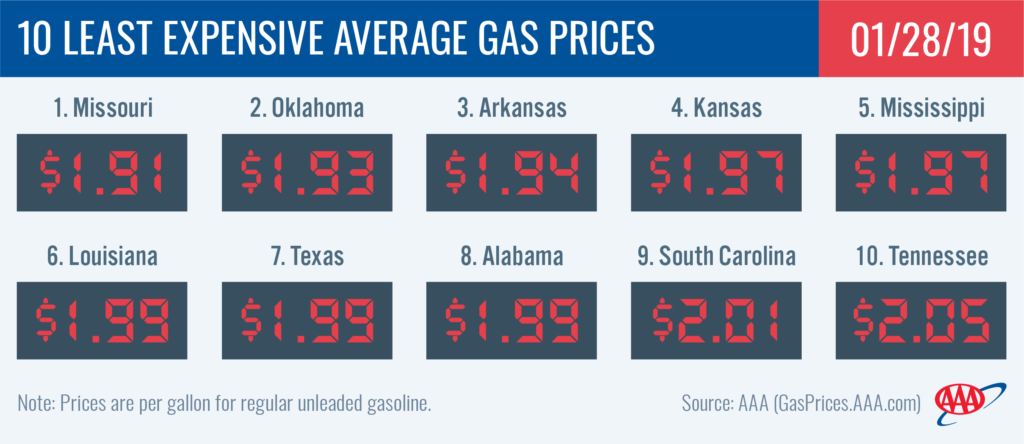Many motorists filling up across the country are noticing gas prices that are increasing slightly. While nearly 25 states’ averages increased on the week, the national average is only a penny more than a week ago at $2.26. The fluctuating national and state gas price averages come alongside an increase in gasoline demand and reflect the higher crude oil prices as of late, but it’s likely not to be a long-term trend.
“With gasoline stocks sitting at their highest level on record – 259.1 million bbl coupled with colder-than-normal weather forecasted for much of the Midwest and East Coast, motorists are likely to see demand drop and gas prices decrease or hold steady this week,” said Jeanette Casselano, AAA spokesperson.
Today’s national gas price average is three cents cheaper than a month ago and 33 cents less expensive than a year ago.
Quick Stats
- The nation’s top 10 largest weekly changes are: Ohio (+10 cents), Michigan (+9 cents), Indiana (+8 cents), Georgia (+7 cents), Texas (+5 cents), North Carolina (+5 cents), Alabama (+5 cents), Alaska (-5 cents), Utah (-5 cents) and Tennessee (+4 cents).
- The nation’s top 10 least expensive markets are: Missouri ($1.91), Oklahoma ($1.93), Arkansas ($1.94), Kansas ($1.97), Mississippi ($1.97), Louisiana ($1.99), Texas ($1.99), Alabama ($1.99), South Carolina ($2.01) and Tennessee ($2.05).
Great Lakes and Central
The majority of Great Lakes and Central states are paying more to fill up on the week with gas prices fluctuating from $1.91 to $2.15 in the region. Of the nine states with more expensive gas prices, Ohio (+10 cents), Michigan (+9 cents) and Indiana (+8 cents), saw the biggest week-over-week changes while the other six states’ averages increased just one to three cents. All other states saw gas prices decrease as much as four cents or hold steady week-over-week.
Winter weather is likely one factor contributing to the higher prices. While colder temperatures do influence motorists to drive less, it can also influence retailers to increase prices ahead of winter storms, especially at times when motorists are stocking up or panic buying. However, the region’s high stock levels are helping to keep most price jumps moderate.
Gasoline stocks in the region sit at their largest level since 2016, a total of 61.2 million bbl. According to the Energy Information Administration (EIA), that is a 6.1 million bbl year-over-year surplus.
South and Southeast
For the states in this region seeing more expensive gas prices, this week’s increases are between one to seven cents more with Georgia (+7 cents), Texas (+5 cents) and Alabama (+5 cents), seeing the largest jumps, as well as landing on the top 10 list among states with the biggest changes this past week. After a large jump the week prior, Florida’s gas price average has decreased a penny to $2.22, while New Mexico ($2.07) also saw a drop and Oklahoma’s average held steady at $1.93. The region’s hefty 90 million bbl stock level, which held relatively flat on the week according to EIA data, is helping to keep any price pump increases moderate.
Rockies
Utah (-5 cents), Wyoming (-4 cents), Idaho (-3 cents), Montana (-3 cents) and Colorado (-3 cents) continue to see some of the largest gas price decreases in the country. Motorists in the Rockies region may be asking themselves ‘how low can gas prices go this winter?’, especially as Colorado continues to flirt with the $2/gal mark. Today’s averages: Idaho ($2.39), Utah ($2.38), Wyoming ($2.39), Montana ($2.26) and Colorado ($2.07).
Gasoline stocks in the region held flat on the week and continue to measure at 7.2 million bbl for the region per EIA data.
Mid-Atlantic and Northeast
State gas price averages are as much as a nickel more in the Mid-Atlantic and Northeast region on the week: North Carolina (+5 cents) and Tennessee (+4 cents). However, more states saw gas prices decrease than increase: Rhode Island (-3 cents), New Hampshire (-3 cent), New York (-2 cents), Massachusetts (-2 cents), Connecticut (-2 cents) and Vermont (-2 cents) saw the largest drops. Despite the decreases, Connecticut ($2.52) and New York ($2.51) land on this week’s top 10 states with the most expensive average in the country.
With a 2 million bbl build, EIA data measures the region’s gasoline stocks at a staggering 68 million bbl. The large stock continues to minimize fluctuation at the pump.
West Coast
Pump prices in the West Coast region are the highest in the nation, with all of the region’s states landing on the nation’s top 10 most expensive list. California ($3.25) is the most expensive market followed by Hawaii ($3.24), Washington ($2.92), Alaska ($2.87), Nevada ($2.87), Oregon ($2.80) and Arizona ($2.51). While expensive, prices are falling with all state averages moving lower on the week. Alaska (-5 cents) saw the largest drop.
EIA’s recent weekly report showed that West Coast gasoline stocks grew by approximately 900,000 bbl to 32.4 million bbl. However, stocks are approximately 2.2 million bbl lower than at this time last year, which could cause prices to spike if there is a supply challenge in the region this week.
Oil market dynamics
At the close of Friday’s formal trading session on the NYMEX, WTI increased 56 cents to settle at $53.69. Overall, crude prices fell slightly last week after new EIA data showed that domestic crude oil inventories grew by an astonishing 8 million bbl last week. At 445 million bbl, the current crude inventory level is approximately 33 million bbl higher than last year at this time.
Moving into this week, increased political turmoil in Venezuela, which has seen reduced crude production during its prolonged political upheaval and economic decline, could elevate crude prices. As a result of the political crisis, the U.S. signaled that it may impose sanctions on crude exports from the country after the Trump Administration decided to recognize Venezuela’s opposition leader as interim president. Implementing crude sanctions could exert global pressure that pushes the sitting president out of office, while tightening the global supply of crude and raising crude prices.
In related news, Baker Hughes Inc. reported that the U.S. added 10 oil rigs, bringing the total to 862. When compared to last year at this time, there are 103 more rigs this year.
Motorists can find current gas prices along their route with the free AAA Mobile app for iPhone, iPad and Android. The app can also be used to map a route, find discounts, book a hotel and access AAA roadside assistance. Learn more at AAA.com/mobile.


